

XSPC RS120 Radiator Pressure Drop Flow Testing
Introduction
Welcome to my pressure drop testing of the XSPC RS120 radiator. I would like to give special thanks to Paul from XSPC for yet another great product to review, the products I have tested have all suprised me in the amount of attention XSPC gives towards top performance at great prices. They really put 100% into making products that perform well!
With this review I will focus on the pressure drop and flow characteristics for this radiator.

Radiator Characteristics
The radiator is a typical brass chamber and tube construction with copper fin similar in fin density and size of the swiftech MCR quiet series or the HWlabs BIP series. I found that it had the following characteristics:- Copper Fins (13 folds per inch)
- Brass Chambers
- G1/4 barb ports to accept a wide variet of G1/4 fittings
- Gloss black paint finish
- 4.75" (120mm) width
- 6" (150mm) hieght
- 1.35" (34.5mm) thickness
- 12.2 ounces (without barbs) weight
- ROHS compliant
Hydraulics and Pressure Drop Testing
The most scientific way to determine a blocks hydraulic resistance is to test pressure drop. Pressure drop is a measurement of pressure loss across a radiator that varies with flow rate. This is basically a measurement of energy loss, and directly influences how much flow rate you will have.Equipment:
- Dwyer Digital Manometer 477 Mark V - Accuracy .5% of Full Scale. Range 0-20.00 PSI range, Resolution .01 PSI
- King Instruments 7520 Series 0-5GPM, 250mm scale - Accuracy 2% of Full Scale. Range 0-5GPM, Resolution .1 GPM (can be interpolated to .02GPM)
- Water Source - Household water pressure - 50PSI at >5GPM - Because flow rate readings are instantaneous, household tap water and water pressure are a good and powerful source for pressure drop testing.
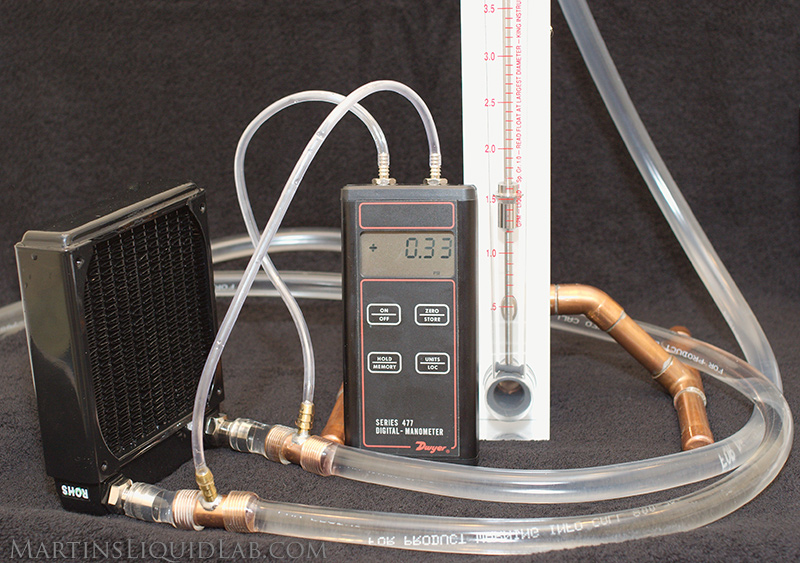
And my results are as follows, the pressure drop results are very very good!
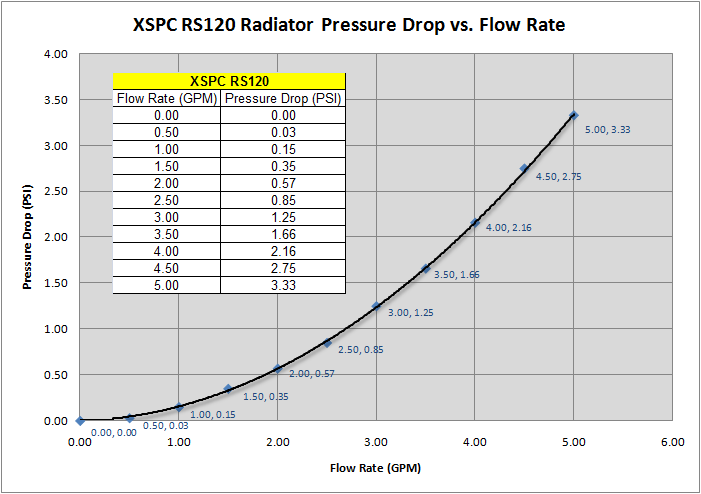
And if you're not familiar with
what this means, I'm providing a relative chart below comparing a few
other published and tested curves to the acquired results. Keep
in mind these comparison
curves were based on other testing facilities, so there could be some
error in different test beds but pressure drop is generally a fairly
repeatable test if good equipment is used. The XSPC RS120 is
right near the
bottom of the group providing very minimal pressure drop similar to the
HWlabs BIX series which is
excellent!

This will allow you to maximize your system flow rates for excellent
thermal efficiency in your water blocks. This is yet another great product from XSPC with
bottom line performance.
At watercoolingshop.com the prices were including VAT
XSPC RS120 = £17.99
Thermchill PA120.1 = £43.99
HWlabs BI GTS = £25.99
So in terms of cost you can save 31% over a similar GTS radiator and 59% less than a Thermochill PA120.1, that's a great price!
The following results were obtained:
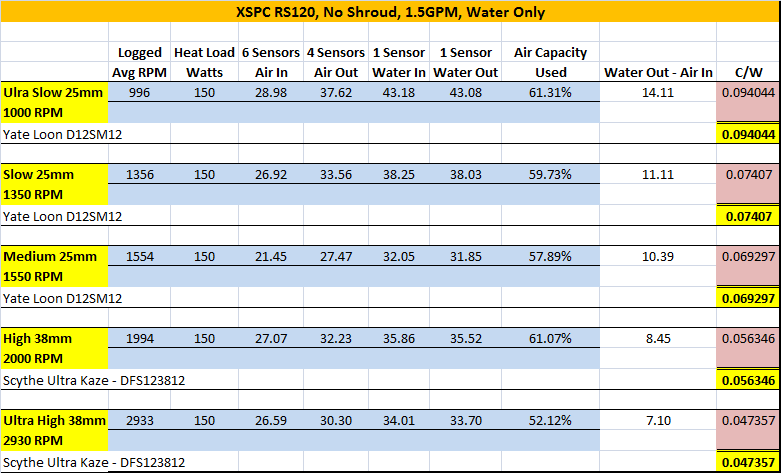
First are my tabular results which includes additional data like the air in and air out, etc. This is fairly typical of a slim 21mm thickness lower density radiator optimized for low speed fans.
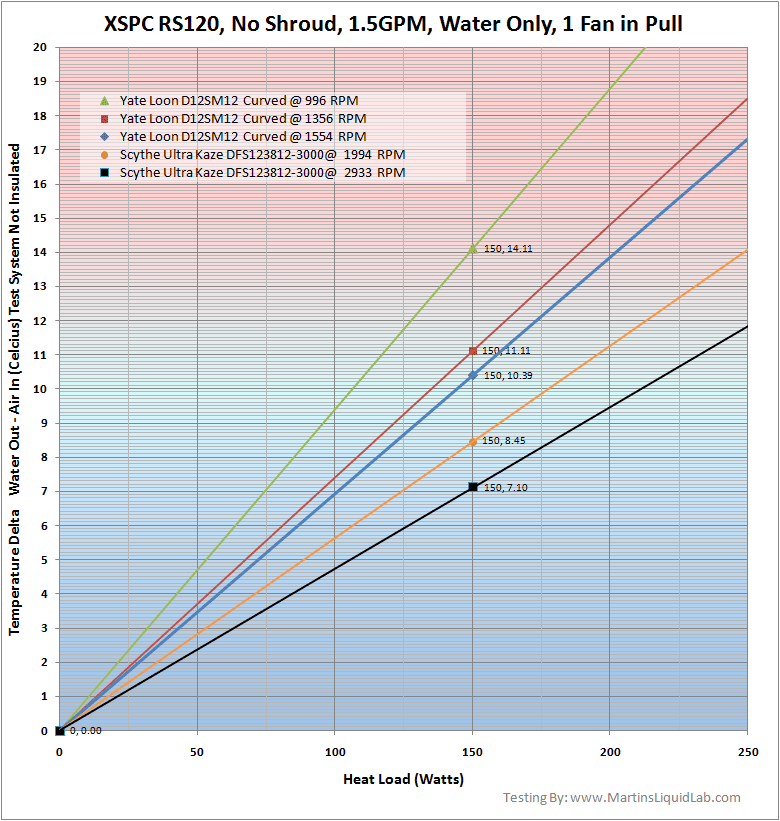
And this is the estimating chart where you can select a heat load in watts and get an estimated water temperature. For example assuming I was running a 200 watt quad core setup using Ultra Kaze fans at 2930RPM, I would get about a 9.5C delta. So if my ambient temperature was 20C, my water temperature would be around 29.5C.

Cost Comparison
So another important consideration with most people is cost. For a fair cost comparison, I chose the good folks at watercoolingshop.com since they carry both the XSPC and Thermochill PA series radiators.At watercoolingshop.com the prices were including VAT
XSPC RS120 = £17.99
Thermchill PA120.1 = £43.99
HWlabs BI GTS = £25.99
So in terms of cost you can save 31% over a similar GTS radiator and 59% less than a Thermochill PA120.1, that's a great price!
Thermal Testing
This is my first only only single 120mm radiator I've tested thermally, so unfortunately, I can't provide you a comparison here. I did however do my normal radiator testing (See Thermal Testing Specification on this page) on this radiator using my crystalfontz to log two air inlet, two air outlet, a water inlet, and a water outlet over 5 1-hour tests. Each test was run using a different fan and RPM setting to give you a nice broad range of performance figures. Flow rate was fixed at 1.5 GPM and heat load was provided by a modified aquarium water heater plus an assumed 15 watts for the DDC2 pump for a total of 150 watts which was kept within a couple of watts using a variac. Each fan was tested the same using a pull configuration without shroud. I also decided because this is a single radiator, one 150 watt heat load would be sufficient.The following results were obtained:

First are my tabular results which includes additional data like the air in and air out, etc. This is fairly typical of a slim 21mm thickness lower density radiator optimized for low speed fans.

And this is the estimating chart where you can select a heat load in watts and get an estimated water temperature. For example assuming I was running a 200 watt quad core setup using Ultra Kaze fans at 2930RPM, I would get about a 9.5C delta. So if my ambient temperature was 20C, my water temperature would be around 29.5C.
To estimate a heat load you can use the following tools:
- Extreme Outer Visions PSU calculator - Just note heat load minus the 38 watts included in the start.
- Swiftech's Conroe/Kentsfield CPU calculator - This is actual an estimator for the kit, but it also gives what I think is a more accurate heat load for the processor. Just plug in the field and it will output a heat load in watts.
Also worthy of noting, like any
radiator, there is a significant performance increase between the ultra
slow and ultra high fans, in this case you literally double the
performance using the high speed fans.
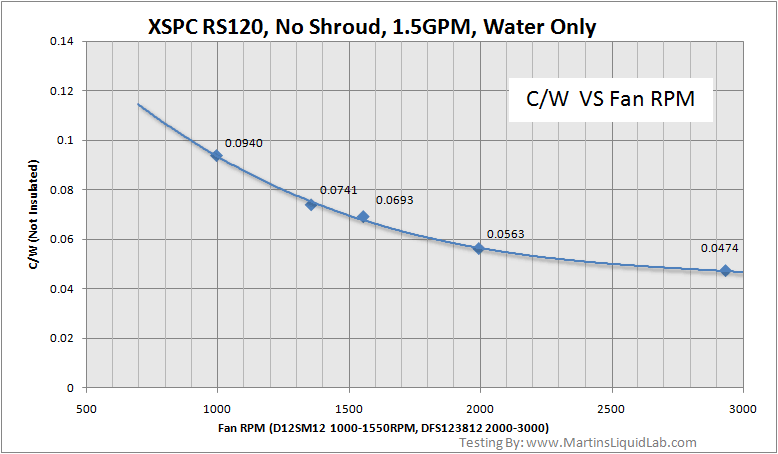
This is just more of a check on my overall testing consistency. I generally expect a slight mismatch where I've switched fans, and overall this looks good. C/W performance has a good steep gain angle in the slow fan speed and leveling off for the high speed fans which is fairly typical of the radiators that are optimized for low speed fans.

And this is a similar thing although it's converted for a 10C delta. Most radiator manufacturers post in 10C delta figures, so I call all 10C figures an average performance level. So you could run a hot 200W overclocked quad core at this level with the higher speed fans, but I wouldn't try with low speed fans. An overclocked dual core on the other hand will do fine with lower speed fans.
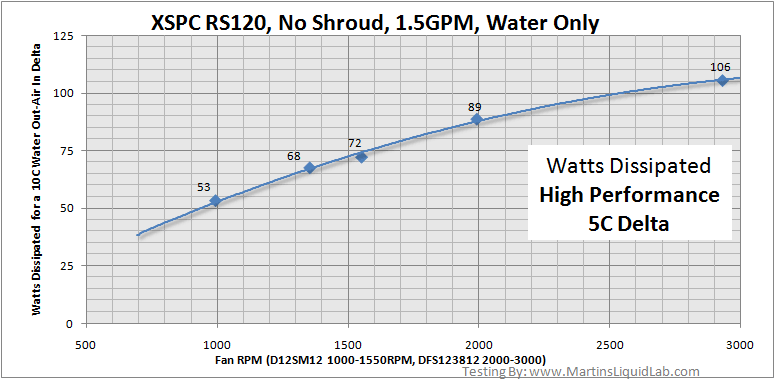
And this is the same thing for what I call a high performance 5C delta. Some of the newer much cooler processors, or a stock processor could easily run at this performance level or an overclocked dual core with the ultra high speed fans could also do ok. Anything more and you'll need to be looking at something like the RS240 to handle the heat.

This is just more of a check on my overall testing consistency. I generally expect a slight mismatch where I've switched fans, and overall this looks good. C/W performance has a good steep gain angle in the slow fan speed and leveling off for the high speed fans which is fairly typical of the radiators that are optimized for low speed fans.

And this is a similar thing although it's converted for a 10C delta. Most radiator manufacturers post in 10C delta figures, so I call all 10C figures an average performance level. So you could run a hot 200W overclocked quad core at this level with the higher speed fans, but I wouldn't try with low speed fans. An overclocked dual core on the other hand will do fine with lower speed fans.

And this is the same thing for what I call a high performance 5C delta. Some of the newer much cooler processors, or a stock processor could easily run at this performance level or an overclocked dual core with the ultra high speed fans could also do ok. Anything more and you'll need to be looking at something like the RS240 to handle the heat.
Shroud or push/pull gains
I used this very radiator to do a whole bunch of fan orientation and shroud performance gains here. I saw some significant performance gains particularly using the 38mm fans in different orientations. Installing two 38mm fans in push pull on this radiator provided nearly a 25% gain over one fan in pull, or just one 38mm fan in push with a 30mm shroud provided a 19% gain. All of this testing and results on this page was done with a single fan in pull condition so you double up on fans in push/pull or use a shroud, you'll see better performance.Pros
- Very low pressure drop - Great for adding into existing loops for multiple radiator setups.
- Compact and easy to fit in many locations, works well as a supplimental raditor for existing setups.
- Excellent price point
- Performs well, depending on the fan used can fullfill a wide variety of cooling needs.
- Responsd well to the addition of shrouds or two fans in push/pull.
- Optimized for low speed fans
- M4 tapped screw holes
- G1/4 barbs
Cons
- Depending on the heat load and fans selected, a single 120mm radiator may need additional radiators for high performance cooling.
Where to buy
XSPC Retailers Link
